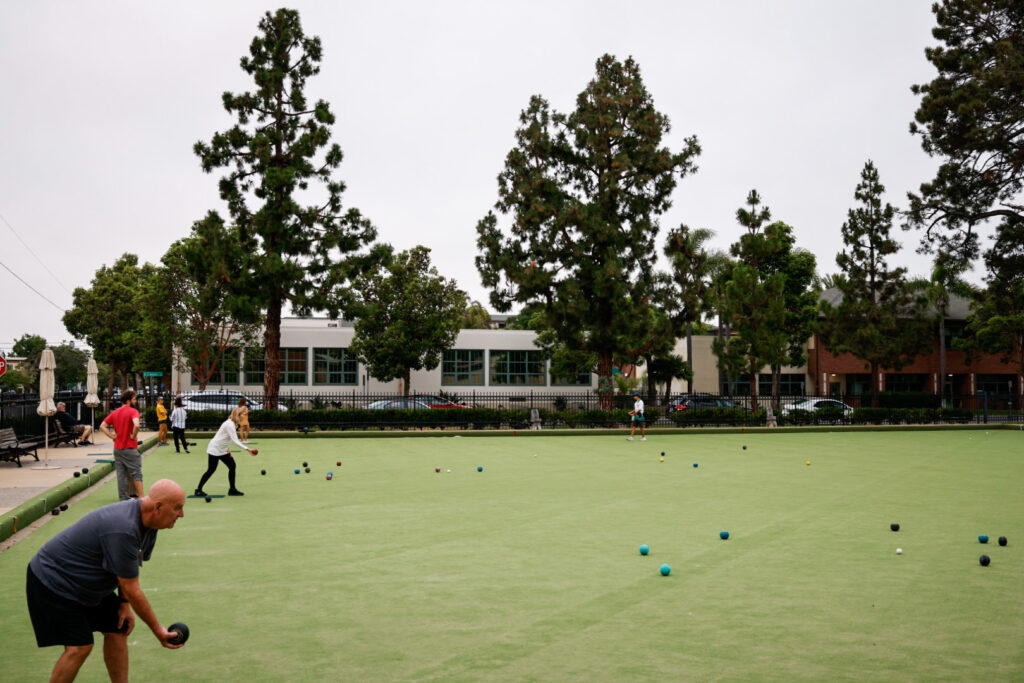
After public dissent and a lawsuit, the Coronado City Council has withdrawn its approval to remove the heavily debated trees adjacent to the city’s lawn bowling green.
“This victory is a culmination of the pressure of our legal case combined with the community’s overwhelming support to save the trees,” said Christine Mott, an attorney and one of the petitioners of the lawsuit.
The four Canary Island pine trees were slated for removal as a part of a project replacing the city’s lawn bowling green. The project also included a nearby Torrey pine that city staff say is unhealthy and is hindering the growth of other trees.
The trees, which line D Ave., came under scrutiny because their roots host puffball fungus, which yields large, hard mounds rendering the lawn bowling green unplayable.
City Council quietly rescinded its approval of the lawn bowling green turf replacements – and the related trees – as a consent item at its Feb. 20 meeting.
Councilmember Casey Tanaka, who opposed the trees’ removal last summer, said he is happy with this outcome.
“It gives the city another opportunity to look at the turf replacement project for the lawn bowling green, and it also gives us another chance to look at the strategy to combat the fungal root ball problem,” he said.
The project must come before council again before it can proceed. In the meantime, the Coronado Lawn Bowling Club will continue to use the bowling green in accordance with its use agreement with the city, said Berie Grobe, the club’s president.
The lawn bowling turf needs replacement every 10 years, and it is coming up on 14, Tanaka said, so he expects the matter to come before the City Council again.
Mott is also happy with the move, calling it a “great victory.”
“It shouldn’t have taken a lawsuit to get the city to do the right thing,” Mott said, “but we trust that this ordeal will refocus the city’s efforts to prioritize good stewardship of our environment and respect for the voice of the community.”
The context
The city approved the trees’ removal last summer, after attempts to mitigate using fungicide were unsuccessful.
The decision sparked debate. On one side, the Coronado Lawn Bowling Club said the service they offer the community provides enough value that alternative landscaping should be considered. On the other, residents said removing the large trees does a disservice to the environment and the city.
In the wake of that debate, Tanaka asked that council reconsider its decision. After a second deliberation, the council opted in a 4-1 vote to move forward with removing the trees, which are on the city’s restricted use tree list, largely due to their roots. The oldest two trees are about 50 years old, while the youngest is about a decade old.
Tanaka cast the dissenting vote.
Next came the lawsuit, which contended that the city erroneously said the matter was exempt under the California Environmental Quality Act (CEQA), which requires, among other things, that projects undergo environmental impact review and that the public be notified ahead of decisions regarding significant environmental changes.
The court issued an injunction against the trees’ removal in October.
“The city saw the writing on the wall based on the October order,” Mott said. “They were going to lose and so it didn’t make sense to continue to litigate. Abandoning the project was the easiest way for the city to end the case and stop spending city money and efforts in a losing battle.”
As City Council weighed the trees’ future last summer, the majority opinion was that it was a shame to lose the trees, but that removing and replacing them with trees that are not on the city’s restricted list would be the most economically and logically prudent solution. Removing the trees would have cost about $6,000 total.
Many people questioned whether there was a way to keep both the trees and the lawn bowling green, but there was no clear solution. Staff reports said a root barrier might work, but some pointed out that a tree losing a significant part of its root system could cause its own problems.
Some suggested the artificial turf helped incubate the fungus and that a natural turf would be better. However, city-enlisted experts said the issue would persist with a natural turf lawn, which would also be more expensive.
In 2021, city staff had also recommended the trees’ removal, but council at the time struck it down in favor of trying to protect the trees. A report from that year said the fungus could live on dead roots, but since then, experts have determined that the fungus can live temporarily on severed roots, but once its nutrient source dries up, the fungus dies.
“Today’s victory is cause for celebration throughout the community,” a release on attorney Bryan Pease’s website reads. “The public has made its voice loud and clear: We speak for the trees.”





